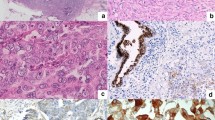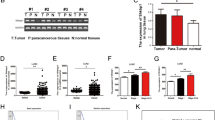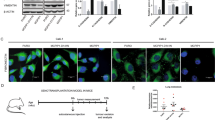Abstract
The epithelial–mesenchymal transition (EMT) induced by chemotherapeutic agents promotes malignant tumor progression; however, the mechanism underlying the drug-induced EMT remains unclear. In this study, we reported that miR-448 is the most downregulated microRNA following chemotherapy. Suppression of miR-448 correlated with EMT induction in breast cancer in vitro and in vivo. With the use of chromatin immunoprecipitation-seq analysis, we demonstrated that miR-448 suppression induces EMT by directly targeting special AT-rich sequence-binding protein-1 (SATB1) mRNA, leading to elevated levels of amphiregulin and thereby, increasing epidermal growth factor receptor (EGFR)-mediated Twist1 expression, as well as nuclear factor κB (NF-κB) activation. On the other hand, we also found that the adriamycin-activated NF-κB directly binds the promoter of miR-448 suppressing its transcription, suggesting a positive feedback loop between NF-κB and miR-448. Furthermore, all patients who received cyclophosphamide (CP), epirubicin plus taxotere/CP, epirubicin plus 5-fluorouracil chemotherapy showed miR-448 suppression, an increased SATB1, Twist1 expression and acquisition of mesenchymal phenotypes. These findings reveal an underlying regulatory pathway, in which the autoregulation between NF-κB and miR-448 is important for restrain miR-448 suppression upon chemotherapy and may have a role in the regulation of chemotherapy-induced EMT. Disruption of the NF-κB-miR-448 feedback loop during clinical treatment may improve the chemotherapy response of human breast cancers in which EMT is a critical component.
Similar content being viewed by others
Log in or create a free account to read this content
Gain free access to this article, as well as selected content from this journal and more on nature.com
or
Abbreviations
- EMT:
-
epithelial–mesenchymal transition
- miRNA:
-
microRNA
- TSS:
-
transcription start site
- ChIP:
-
chromatin immunoprecipitation
- SATB1:
-
special AT-rich sequence-binding protein-1
- AR:
-
amphiregulin
- EGFR:
-
epidermal growth factor receptor
- NF-κB:
-
nuclear factor κB
- CK:
-
cytokeratin
- DM:
-
daunomycin
- CP:
-
cyclophosphamide
- 5-FU:
-
5-fluorouracil
- TAM:
-
tamoxifen
- CEF, cyclophosphamide:
-
epirubicin plus 5-fluorouracil
- CET, cyclophosphamide:
-
epirubicin plus taxotere
- CMF:
-
cyclophosphamide, methotrexate plus 5-fluorouracil
- MAPK:
-
mitogen-activated protein kinase
References
Chaudhary PM, Roninson IB . Induction of multidrug resistance in human cells by transient exposure to different chemotherapeutic drugs. J Natl Cancer Inst 1993; 85: 632–639.
Yang JM, Medina GY, Vassil DJ, Liao AD, Hait J . Treatment of multidrug resistant (MDR1) murine leukemia with P-glycoprotein substrates accelerates the course of the disease. Biochem Biophys Res Commun 1999; 266: 167–173.
Yamauchi K, Yang M, Hayashi K, Jiang P, Yamamoto N, Tsuchiya H et al. Induction of cancer metastasis by cyclophosphamide pretreatment of host mice: an opposite effect of chemotherapy. Cancer Res. 2008; 68: 516–520.
Huber MA, Kraut N, Beug H . Molecular requirements for epithelial-mesenchymal transition during tumor progression. Curr Opin Cell Biol. 2005; 17: 1–11.
Thiery JP . Epithelial–mesenchymal transitions in tumour progression. Nat Rev Cancer. 2002; 2: 442–454.
Peinado H, Portillo F, Cano A . Transcriptional regulation of cadherins during development and carcinogenesis. Int J Dev Biol. 2004; 48: 365–375.
Barrallo-Gimeno A, Nieto MA . The Snail genes as inducers of cell movement and survival: implications in development and cancer. Development. 2005; 132: 3151–3161.
Moody SE, Perez D, Pan TC, Sarkisian CJ, Portocarrero CP, Sterner CJ et al. The transcriptional repressor Snail promotes mammary tumor recurrence. Cancer Cell. 2005; 8: 197–199.
Yang J, Mani SA, Weinberg RA . Exploring a new Twist on tumor metastasis. Cancer Res. 2006; 66: 4549–4552.
Mironchik Y, Winnard Jr PT, Vesuna F, Kato Y, Wildes F, Pathak AP et al. Twist overexpression induces in vivo angiogenesis and correlates with chromosomal instability in breast cancer. Cancer Res. 2005; 65: 10801–10809.
Hiscox S, Jiang WG, Obermeier K, Taylor K, Morgan L, Burmi R et al. Tamoxifen resistance in MCF7 cells promotes EMT-like behaviour and involves modulation of beta-catenin phosphorylation. Int J Cancer. 2006; 118: 290–301.
Kajiyama H, Shibata K, Terauchi M, Yamashita M, Ino K, Nawa A et al. Chemoresistance to paclitaxel induces epithelial-mesenchymal transition and enhances metastatic potential for epithelial ovarian carcinoma cells. Int J Oncol. 2007; 31: 277–283.
Li QQ, Xu JD, Wang WJ, Cao XX, Chen Q, Tang F et al. Twist1-mediated adriamycin-induced epithelial-mesenchymal transition relates to multidrug resistance and invasive potential in breast cancer cells. Clin Cancer Res. 2009; 15: 2657–2665.
Bartel DP . MicroRNAs: genomics, biogenesis, mechanism, and function. Cell. 2004; 116: 281–297.
He L, Thomson JM, Hemann MT, Hernando-Monge E, Mu D, Goodson S et al. A microRNA polycistron as a potential human oncogene. Nature. 2005; 435: 828–833.
Voorhoeve PM, le Sage C, Schrier M, Gillis AJ, Stoop H, Nagel R et al. A genetic screen implicates miRNA-372 and miRNA-373 as oncogenes in testicular germ cell tumors. Cell 2006; 124: 1169–1181.
Calin GA, Dumitru CD, Shimizu M, Bichi R, Zupo S, Noch E et al. Frequent deletions and down-regulation of microRNA genes miR-15 and miR-16 at 13q14 in chronic lymphocytic leukemia. Proc Natl Acad Sci 2002; 99: 15524–15529.
Takamizawa J, Konishi H, Yanagisawa K, Tomida S, Osada H, Endoh H et al. Reduced expression of the let-7 microRNAs in human lung cancers in association with shortened postoperative survival. Cancer Res. 2004; 64: 3753–3756.
Johnson SM, Grosshans H, Shingara J, Byrom M, Jarvis R, Cheng A et al. RAS is regulated by the let-7 microRNA family. Cell. 2005; 120: 635–647.
Akao Y, Nakagawa Y, Naoe T . let-7 microRNA functions as a potential growth suppressor in human colon cancer cells. Biol Pharm Bull. 2006; 29: 903–906.
Yanaihara N, Caplen N, Bowman E, Seike M, Kumamoto K, Yi M et al. Unique microRNA molecular profiles in lung cancer diagnosis and prognosis. Cancer Cell. 2006; 9: 189–198.
Zavadil J, Narasimhan M, Blumenberg M, Schneider RJ . Transforming growth factor-beta and microRNA: mRNA regulatory networks in epithelial plasticity. Cells Tissues Organs. 2007; 185: 157–161.
Burk U, Schubert J, Wellner U, Schmalhofer O, Vincan E, Spaderna S et al. A reciprocal repression between ZEB1 and members of the miR-200 family promotes EMT and invasion in cancer cells. EMBO Rep. 2008; 9: 582–589.
Gregory PA, Bert AG, Paterson EL, Barry SC, Tsykin A, Farshid G et al. The miR-200 family and miR-205 regulate epithelial to mesenchymal transition by targeting ZEB1 and SIP1. Nat Cell Biol. 2008; 10: 593–601.
Korpal M, Lee ES, Hu G, Kang Y . The miR-200 family inhibits epithelial-mesenchymal transition and cancer cell migration by direct targeting of E-cadherin transcriptional repressors ZEB1 and ZEB2. J Biol Chem. 2008; 283: 14910–14914.
Park SM, Gaur AB, Lengyel E, Peter ME . The miR-200 family determines the epithelial phenotype of cancer cells by targeting the E-cadherin repressors ZEB1 and ZEB2. Genes Dev. 2008; 22: 894–907.
Bracken CP, Gregory PA, Kolesnikoff N, Bert AG, Wang J, Shannon MF et al. A doublenegative feedback loop between ZEB1-SIP1 and the microRNA-200 family regulates epithelial-mesenchymal transition. Cancer Res. 2008; 68: 7846–7854.
Christoffersen NR, Silahtaroglu A, Orom UA, Kauppinen S, Lund AH . miR-200b mediates post-transcriptional repression of ZFHX1B. RNA. 2007; 13: 1172–1178.
Han HJ, Russo J, Kohwi Y, Kohwi-Shigematsu T . SATB1 reprogrammes gene expression to promote breast tumour growth and metastasis. Nature. 2008; 452: 187–193.
Mani SA, Guo W, Liao MJ, Eaton EN, Ayyanan A, Zhou AY et al. The epithelial-mesenchymal transition generates cells with properties of stem cells. Cell. 2008; 133: 704–715.
Davis BN, Hilyard AC, Lagna G, Hata A . SMAD proteins control DROSHA-mediated microRNA maturation. Nature. 2008; 454: 56–61.
Funatomi H, Itakura J, Ishiwata T, Pastan I, Thompson SA, Johnson GR et al. Amphiregulin antisense oligonucleotide inhibits the growth of T3M4 human pancreatic cancer cells and sensitizes the cells to EGF receptor-targeted therapy. Int J Cancer. 1997; 72: 512–517.
Castillo J, Erroba E, Perugorría MJ, Santamaría M, Lee DC, Prieto J et al. Amphiregulin contributes to the transformed phenotype of human hepatocellular carcinoma cells. Cancer Res. 2008; 66: 6129–6138.
Streicher KL, Willmarth NE, Garcia J, Boerner JL, Dewey TG, Ethier SP . Activation of a nuclear factor kappaB/interleukin-1 positive feedback loop by amphiregulin in human breast cancer cells. Mol Cancer Res. 2007; 5: 847–861.
Streicher KL, Willmarth NE, Garcia J, Boerner JL, Dewey TG, Ethier SP . Autocrine action of amphiregulin in a colon carcinoma cell line and immunocytochemical localization of amphiregulin in human colon. J Cell Biol. 1992; 118: 741–751.
Thomson S, Buck E, Petti F, Griffin G, Brown E, Ramnarine N et al. Epithelial to mesenchymal transition is a determinant of sensitivity of non-small-cell lung carcinoma cell lines and xenografts to epidermal growth factor receptor inhibition. Cancer Res. 2005; 65: 9455–9462.
Yauch RL, Januario T, Eberhard DA, Cavet G, Zhu W, Fu L et al. Epithelial versus mesenchymal phenotype determines in vitro sensitivity and predicts clinical activity of erlotinib in lung cancer patients. Clin Cancer Res. 2005; 11: 8686–8698.
Del Castillo G, Murillo MM, Alvarez-Barrientos A, Bertran E, Fernández M, Sánchez A et al. Autocrine production of TGF-beta confers resistance to apoptosis after an epithelial-mesenchymal transition process in hepatocytes: Role of EGF receptor ligands. Exp Cell Res 2006; 312: 2860–2871.
Huber MA, Azoitei N, Baumann B, Grünert S, Sommer A, Pehamberger H et al. NF-kappaB is essential for epithelial-mesenchymal transition and metastasis in a model of breast cancer progression. J Clin Invest 2004; 114: 569–581.
Kim I, Moon SO, Kim SH, Kim HJ, Koh YS, Koh GY . Vascular endothelial growth factor expression of intercellular adhesion molecule 1 (ICAM-1), vascular cell adhesion molecule 1 (VCAM-1), and E-selectin through nuclear factor-kappa B activation in endothelial cells. Biol Chem 2001; 276: 7614–7620.
Acknowledgements
This work was supported by grants from the National Nature Science Foundation of China (No. 81071813 and No. 30870972). We thank members of our laboratory for helpful discussions.
Author information
Authors and Affiliations
Corresponding authors
Ethics declarations
Competing interests
The authors declare no conflict of interest.
Additional information
Edited by M Oren
Supplementary Information accompanies the paper on Cell Death and Differentiation website
Supplementary information
Rights and permissions
About this article
Cite this article
Li, QQ., Chen, ZQ., Cao, XX. et al. Involvement of NF-κB/miR-448 regulatory feedback loop in chemotherapy-induced epithelial–mesenchymal transition of breast cancer cells. Cell Death Differ 18, 16–25 (2011). https://doi.org/10.1038/cdd.2010.103
Received:
Revised:
Accepted:
Published:
Issue date:
DOI: https://doi.org/10.1038/cdd.2010.103
Keywords
This article is cited by
-
Understanding crosstalk of organ tropism, tumor microenvironment and noncoding RNAs in breast cancer metastasis
Molecular Biology Reports (2023)
-
Heterogeneous circulating tumor cells correlate with responses to neoadjuvant chemotherapy and prognosis in patients with locally advanced breast cancer
Breast Cancer Research and Treatment (2023)
-
Review article epithelial to mesenchymal transition‑associated microRNAs in breast cancer
Molecular Biology Reports (2022)
-
Interplay between p53 and non-coding RNAs in the regulation of EMT in breast cancer
Cell Death & Disease (2021)
-
SATB family chromatin organizers as master regulators of tumor progression
Oncogene (2019)



